Every living space needs heating. Moreover, the heating equipment must be of high quality. After all, almost half a year of cold weather, the heating system should function properly. When planning a heating system, many are wondering whether steel or bimetallic radiators are better and, after comparing the characteristics of both types, they still opt for bimetal. Indeed, due to the high heat transfer rates, neat appearance, it is these batteries that are practical, durable and allow you to create comfort in the apartment, fill the room with warmth.
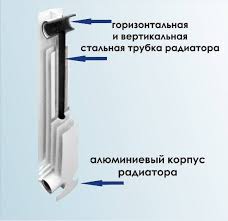 In addition, you can install them yourself. This does not require much destruction, it is carried out quite simply and accurately. The main thing is to know the basic rules and carry out the correct calculation of the device parameters. If you do not know how to properly install a bimetallic heating radiator, this article is for you. We will consider the design of radiators, installation features, and also briefly describe some of the most popular models for heating system equipment.
In addition, you can install them yourself. This does not require much destruction, it is carried out quite simply and accurately. The main thing is to know the basic rules and carry out the correct calculation of the device parameters. If you do not know how to properly install a bimetallic heating radiator, this article is for you. We will consider the design of radiators, installation features, and also briefly describe some of the most popular models for heating system equipment.
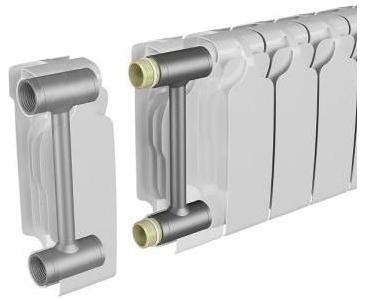 It should be noted that the device of bimetallic heating radiators is quite simple. The design consists of the radiators themselves, as well as steel pipes adjacent to them. The joints are processed by spot welding.
It should be noted that the device of bimetallic heating radiators is quite simple. The design consists of the radiators themselves, as well as steel pipes adjacent to them. The joints are processed by spot welding.
The radiator is a metal pipe. Inside is iron. This is an ideal material that is perfect for a metal heating complex. Because it holds pressure more effectively. On top of the pipe is covered with an aluminum layer. This improves the thermal conductivity. And since two metals are used in the manufacture of the battery, it was called bimetallic. Using bimetal heating radiators become more durable, have high performance characteristics. You can read more about the technical characteristics of bimetallic radiators.
Bimetallic radiators can be of two types:
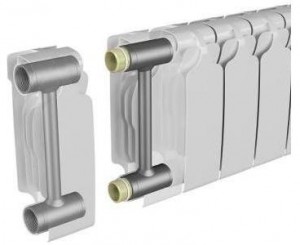
Bimetal batteries are recommended to be installed in apartments with a central water heating complex based on iron and steel. It should be noted that the cost of bimetallic heating radiators is quite acceptable and depends on the power characteristics of the model and the size of the equipment.
In order for the radiator installation to be correct, it is important to make an accurate calculation of the number of sections.
How to calculate the number of sections?
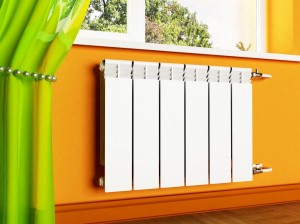 In order to get an accurate calculation, it is better, of course, to entrust this work to specialists. If you decide to carry out the installation of a bimetallic radiator yourself, then you should know the features of the calculation.
In order to get an accurate calculation, it is better, of course, to entrust this work to specialists. If you decide to carry out the installation of a bimetallic radiator yourself, then you should know the features of the calculation.
You will need two metrics: living area and power level of the selected battery model. Manufacturers indicate the power of bimetallic heating radiators in the device passport. The size of the area must be divided by 10. This is necessary to calculate 1 kW per 10 sq.m. The resulting number should be divided by the power of the bimetallic heating device. The number obtained as a result of division must be rounded up to integers (up). This allows you to get information about the required number of sections.
Installation of bimetallic batteries
It is necessary to carry out the installation of the heating device strictly according to the instructions set out in the device passport.
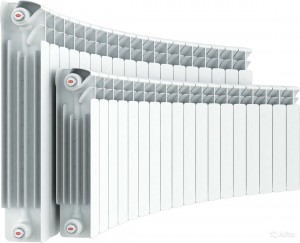
It clearly describes the procedure for connecting bimetallic heating radiators for a specific model. It should be noted that the installation of all elements of the system is carried out in a polyethylene package of the radiator. And you can not remove this packaging until the entire installation process is completed.
Consider how to connect a bimetallic heating radiator yourself. When carrying out installation work, the following nuances must be taken into account:
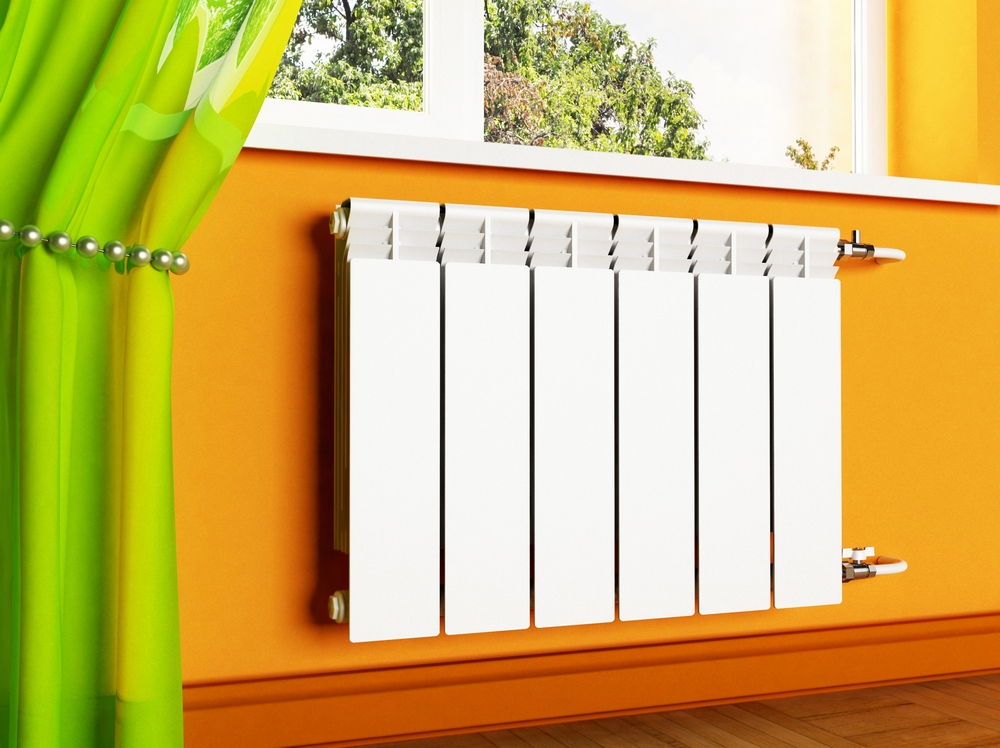
The installation algorithm for a bimetallic radiator is as follows:

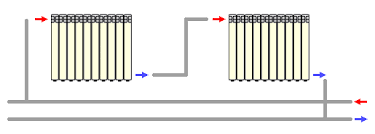
Which radiator is better to install?
The modern market offers a wide variety of brands from different manufacturers. There are domestic and imported options. Among foreign models, Italian or German bimetallic heating radiators are popular.
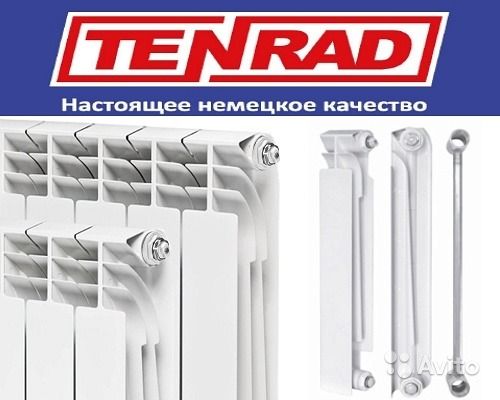 Popular German-made batteries include Tenrad radiators. All products of this company are distinguished by reliability and high performance parameters. The fins are three-row, which provides good heat transfer performance.
Popular German-made batteries include Tenrad radiators. All products of this company are distinguished by reliability and high performance parameters. The fins are three-row, which provides good heat transfer performance.
Among Italian products, it is worth considering the Italian bimetallic heating radiators Global STYLE PLUS 500. A side scheme is used to connect such a unit. The device is mounted on the wall. Due to the excellent technical characteristics and attractive appearance, the feedback on the bimetallic radiator Global STYLE PLUS 500 is only positive. Most often, users note efficient operation and durability. Heat dissipation is 185 watts. And the temperature of the coolant can reach a maximum mark of 110 degrees. There are numerous reviews on Global heating radiators.
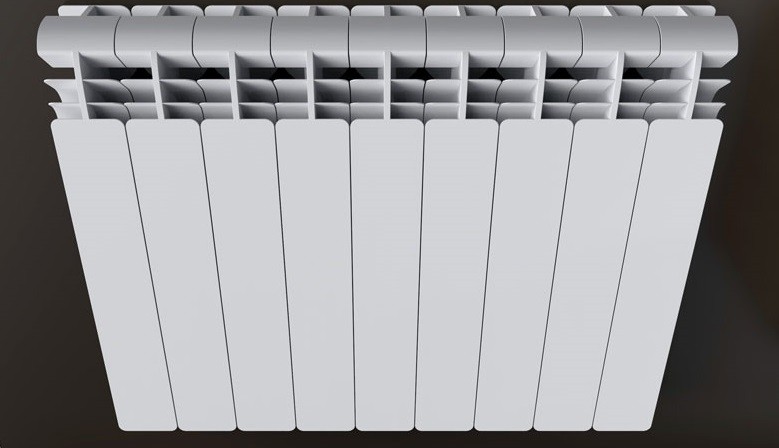 You can also highlight the Italian radiators XTREME. This model is new. At minimal cost, the device gives maximum heat transfer. Italy produces such bimetallic heating radiators specifically for installation in Russian heating systems. The model is designed to work in difficult conditions. For example, with low water quality, the unit works perfectly in high temperatures and pressures. User reviews are positive for the XTREME bimetallic radiator: good heat dissipation, low price.
You can also highlight the Italian radiators XTREME. This model is new. At minimal cost, the device gives maximum heat transfer. Italy produces such bimetallic heating radiators specifically for installation in Russian heating systems. The model is designed to work in difficult conditions. For example, with low water quality, the unit works perfectly in high temperatures and pressures. User reviews are positive for the XTREME bimetallic radiator: good heat dissipation, low price.
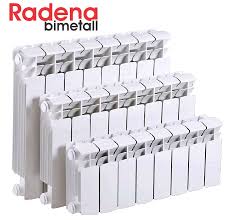 The Italian company Radena also specializes in the production of bimetallic batteries. Only high carbon steel is used for manufacturing. The working pressure is 25 atmospheres. And the temperature of the environment reaches 100 degrees. There are batteries with a standard side connection and with a bottom connection. The reviews on Raden heating radiators are positive. Durability, good design, the possibility of using in one-pipe and two-pipe heating systems with horizontal and vertical placement of heat pipes are noted.
The Italian company Radena also specializes in the production of bimetallic batteries. Only high carbon steel is used for manufacturing. The working pressure is 25 atmospheres. And the temperature of the environment reaches 100 degrees. There are batteries with a standard side connection and with a bottom connection. The reviews on Raden heating radiators are positive. Durability, good design, the possibility of using in one-pipe and two-pipe heating systems with horizontal and vertical placement of heat pipes are noted.
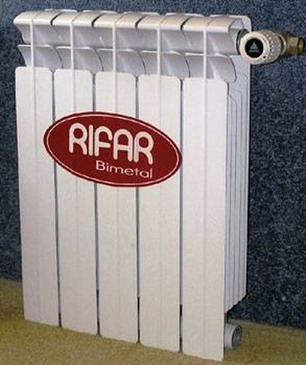 Consider domestic production models. For example, Russian bimetallic heating radiators Rifar Monolith. Although the Rifar brand appeared on the market quite recently, the products of this company have already managed to squeeze out the products of eminent German and Italian manufacturers. Rifar radiators are used in residential and office buildings. They have excellent features. Also, bimetallic radiators fully comply with GOST 31311 2005, TU.
Consider domestic production models. For example, Russian bimetallic heating radiators Rifar Monolith. Although the Rifar brand appeared on the market quite recently, the products of this company have already managed to squeeze out the products of eminent German and Italian manufacturers. Rifar radiators are used in residential and office buildings. They have excellent features. Also, bimetallic radiators fully comply with GOST 31311 2005, TU.
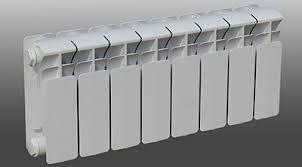 Rifar monolith is available in two sizes: 350 and 500 mm. Most often, radiators with a center distance of 500 mm are used. There are no joints between sections. Therefore, if you decide to install such a battery, you must immediately select the required length.
Rifar monolith is available in two sizes: 350 and 500 mm. Most often, radiators with a center distance of 500 mm are used. There are no joints between sections. Therefore, if you decide to install such a battery, you must immediately select the required length.
For bimetallic heating radiators Rifar Monolith 500, the price is optimally combined with functionality and quality. Installing these batteries is quick and easy. Does not require the use of adapters.
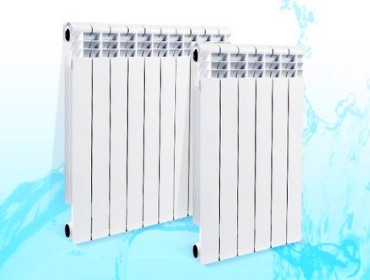 Not so long ago, Russian-made Thermohit radiators also appeared on sale. This equipment belongs to the budget class. It has not yet received wide distribution, therefore, reviews on Termohit heating radiators are not too numerous. Specifications are high. But still the quality is inferior to more expensive models.
Not so long ago, Russian-made Thermohit radiators also appeared on sale. This equipment belongs to the budget class. It has not yet received wide distribution, therefore, reviews on Termohit heating radiators are not too numerous. Specifications are high. But still the quality is inferior to more expensive models.
![]() There are also Chinese-made batteries on the domestic market. Here it is worth noting Oasis radiators. Products have international certification, have good technical characteristics. Reviews of Oasis bimetallic heating radiators are mostly positive. Users highlight such advantages of these units as high technical performance, a long factory warranty and an affordable price.
There are also Chinese-made batteries on the domestic market. Here it is worth noting Oasis radiators. Products have international certification, have good technical characteristics. Reviews of Oasis bimetallic heating radiators are mostly positive. Users highlight such advantages of these units as high technical performance, a long factory warranty and an affordable price.
